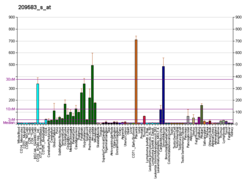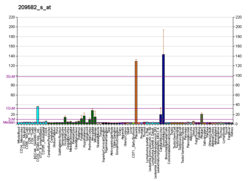Expression
CD200 is expressed on dendritic cells, activated B lymphocytes, activated T lymphocytes, thymocytes, endothelial cells, neurons and osteoblast precursors. Moreover, CD200 is expressed on various types of human cancer cells including hairy cell leukemia, acute myeloid leukemia, chronic lymphocytic leukemia, malignant melanoma, multiple myeloma, testicular cancer, renal carcinoma, colon carcinoma and glioblastoma multiforme. [7] [8]
In innate immunity, cellular CD200 expression is induced upon TLR and NLR activation.
At the transcriptional level, CD200 expression is regulated by C/EBP-β. It has been shown that CD200 expression is induced by IFN-γ and TNF-α in a NF-kappaB-, STAT1- and IRF-1-dependent manner. [7]
Soluble CD200 (sCD200) is present in serum. It was shown that elevated levels of serum sCD200 are associated with adverse tumor prognosis in chronic lymphocytic leukemia, glioblastoma multiforme, ependymoma and medulloblastoma. Furthermore, sCD200 is associated with the expansion of myeloid-derived suppressor cells in patients with glioblastoma multiforme. [8]
Truncated CD200 (CD200tr) is a truncated version of CD200 produced by alternative splicing mechanism. CD200tr lacks approximately 30 amino acids in the NH2-terminal sequence. It was shown that CD200tr acts as a competitive inhibitor to the full length CD200. [7]
Function
CD200 interacts with its receptor CD200R and leads to immunosuppressive signaling. CD200R is strongly expressed on macrophages, neutrophils and mast cells as well as on some subtypes of B lymphocytes and T lymphocytes. In the tumor microenvironment CD200R is expressed on tumor-associated myeloid cells, particularly in tumor-associate macrophages, myeloid-derived suppressor cells, tumor-associated dendritic cells and also in regulatory T lymphocytes. [9] [8]
CD200-CD200R engagement inhibits T-cell immune response, shifts cytokine profile towards Th2 type response, decreases NK cell cytotoxic activity, promotes indoleamin-2,3 dioxygenase production in macrophages and triggers regulatory T cell expansion. CD200 on dendritic and lymphoid effector cells modulates the activation threshold of inflammatory response and thus contributes to the maintenance of self-tolerance. [7] [10] Interaction between CD200 and CD200R results in a down-regulation of basophils function and inhibits lytic function of NK cells. In IFN-γ and TNF-α producing macrophages, CD200-CD200R interaction leads to inhibition of function through Dok2 and RasGAP dependent mechanism. Elevated expression of CD200R on macrophages is associated with alternative activation of macrophages to M2 phenotype. [7]
Clinical significance
Pathogens modulate CD200-CD200R axis
CD200-encoding gene has been acquired by a number of viruses infecting animals as well as human, for example some human herpesviruses.
KSHV, also known as human herpesvirus-8 is, essential for the development of Kaposi sarcoma. This virus produces an ortholog of CD200, known as viral OX2 (vOX2), a 55 kDa protein. This gene is expressed on the surface of infected cells during viral replicative state. vOX-2 has an approximately 40% sequence similarity with the human gene for CD200 but shares key residues with CD200 in its binding site for CD200R. Due to its ability to engage CD200R, vOX2 can target host immune cells (T lymphocytes, macrophages, neutrophils, basophils) and inhibit anti-viral activity. Particularly, vOX2 is capable of decreasing production of TNF-α, IFN-γ from macrophages and T lymphocytes and the CD170a-dependent activation of NK cells.
Leishmania amazonensis induces expression of CD200 in the bone marrow macrophages a thus inhibits neighboring macrophages expressing CD200R that inhibits NO production during infection. Infection with Taenia crassiceps and Trypanosoma brucei brucei leads to an overexpression of CD200R on M2 macrophages and consequently to the inhibition of innate immunity response. [7]
Rat cytomegalovirus also express CD200 ortholog known as e127 protein interacts with CD200R. e127 protein is expressed on the surface of infected cells. [8]
In cancer
CD200 is overexpressed in cancer cells in a number of human tumors including melanoma, ovarian cancer, some B-cell malignances and small cell lung carcinoma. In the tumor microenvironment CD200 is also expressed in endothelial cells and activated T lymphocytes, B lymhocytes and myeloid cells. These cells can thus interact with cells expressing CD200R such as T regulatory cells, tumor-associated dendritic cells, tumor associated macrophages and myeloid derived suppressor cells (MDSC). It was shown that CD200 expressed on tumor cells promotes expansion of MDSCs that are capable of inhibiting anti-tumor immune response. CD200 blockade inhibits tumor growth and decreases number of MDSCs in tumor tissue. [7]
The exact relationship between CD200 and cancer development, as well as its impact on disease prognosis, remains unclear and appears to vary depending on the type of tumor. [9]
In transplantation
It was shown that in animal models CD200 prolongs allograft survival. This effect is associated with polarization of cytokine response towards increased production of type-2 cytokines and decreased production of type-1 cytokines. In in vitro experiments, allostimulated cells in the presence of CD200 decreased their cytotoxic function in TGF-β and IL-10 dependent mechanism. [7]
As a drug target
Samalizumab, recombinant humanized monoclonal antibody targeting CD200 was tested in patients with chronic lymphocytic leukemia (CLL) and multiple myeloma as a phase I study. Samalizumab treatments showed a dose-dependent decrease in CD200 expression on CLL cells and decreased frequencies of circulating CD200+ CD4+ T lymphocytes in a majority of CLL patients and in multiple myeloma patients. [10]
This page is based on this
Wikipedia article Text is available under the
CC BY-SA 4.0 license; additional terms may apply.
Images, videos and audio are available under their respective licenses.






